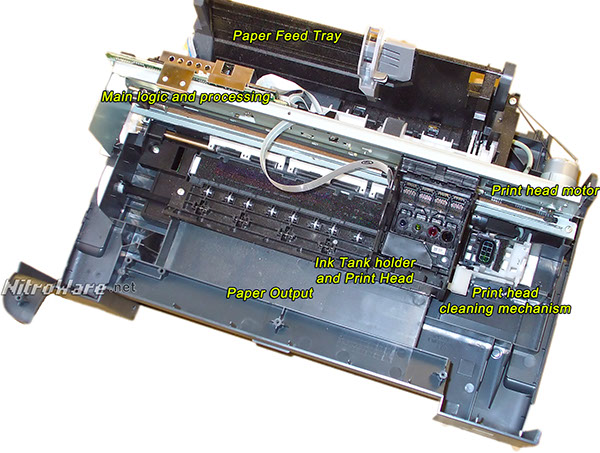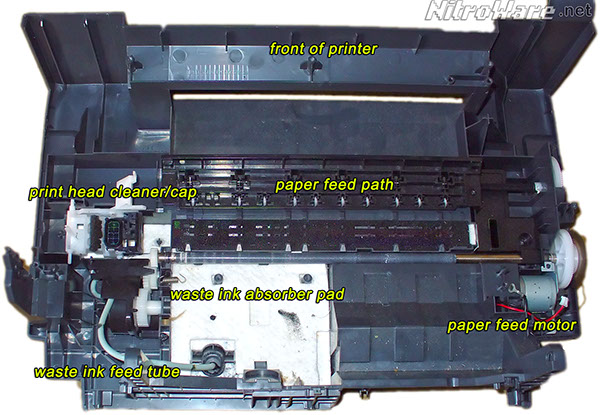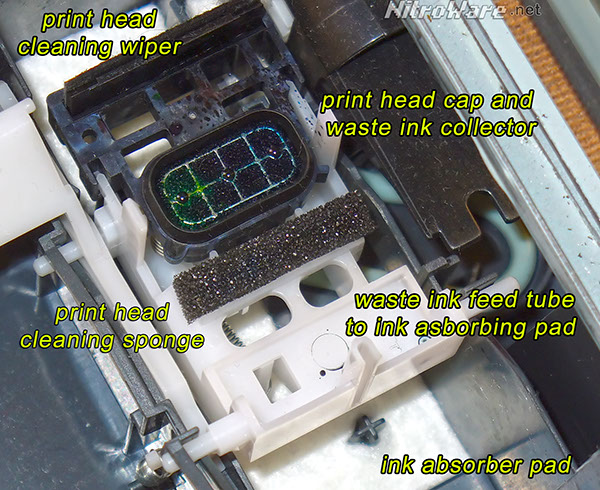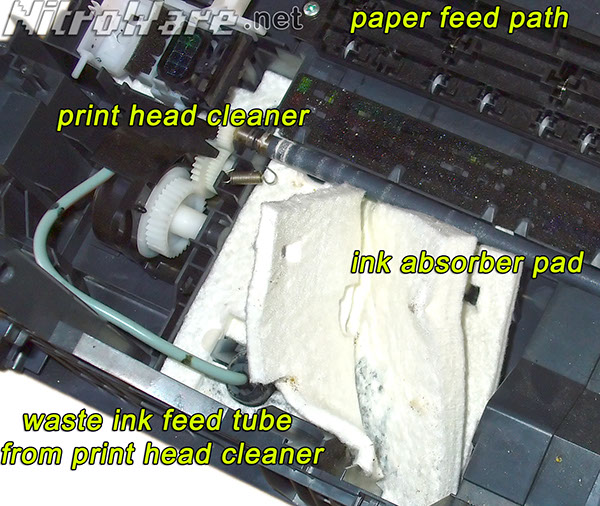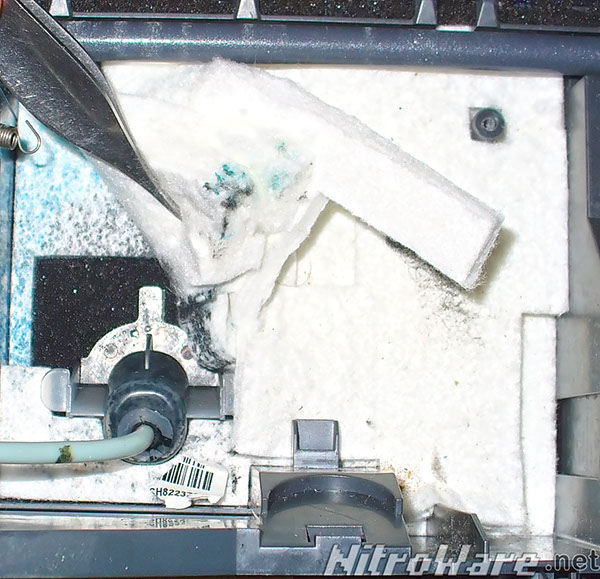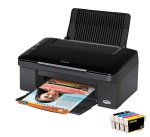 Are you are finding that your inkjet printer ink is being used up quicker than you like? There is valid explanation for this. The ink is going down the drain, literarily.
Are you are finding that your inkjet printer ink is being used up quicker than you like? There is valid explanation for this. The ink is going down the drain, literarily.
Part 1 of our article series showed how a modern printer can fail due to excess ink wastage from heavy or non optimal use.
In Part 2 of our article series we compare our earlier example to a similar printer of specification and age that been has operated more efficiently and highlight the differences between these cases and the overall designs of these examples of moderns printers.
In most inkjet/bubble jet printers there is a device called the ink absorber pad. The size and implementation of this varies between manufacturers and makes but its purpose remains the same. The ink absorber pad is designed to collect any wasted ink that is expelled by the printing head when the printer performs its cleaning cycle.
Wasted ink does not indicate a fault of the printer but is part of normal operation; however when the various ink absorption pads in a printer may fill up the printer may indicate this as an error and printing will not be possible unless the pad is changed and the error cleared.
This type of error is extremely common with printers manufactured in the last several years and leads to otherwise working and good printers being wasted by being thrown out wasting its owner’s money and adding to the landfill problem.
With the cost of printers being what they are the hardware somewhat subsidised at the expense of consumables. This leads to end users who experience an error with their printer will likely go out and buy a new printer rather than have it serviced to clear a fault such as ink absorption pad full especially with lower cost ‘disposable’ consumer grade printers.
When an inkjet printer is turned on from a cold and off state it will go through a deep clean cycle to clear out any old and dried out ink from the printing head to ensure that no ‘gunk’ ends up on the users printed document. The way this is achieved is via the use of cleaning apparatus in the printer such as a rubber or plastic squeeze wiper to swipe the surface of the print head or metal pins.
This approach will clean the surface of the print head but will not clean out the microscopic nozzles in the print head. Thus forcing fresh ink through the print head will clear out any old ink and essentially ‘rinse’ the print head ready for quality printing. The printer will also perform a cleaning cycle based on a schedule or timer as well as printed page count.
The downside of doing this is that precious ink is ‘wasted’ during the cleaning operations. To prevent ink from being wasted try not to turn off your printer from the hard power switch or from the wall. This will only confuse the printer and waste ink through cleaning cycles. It is for this reason inkjet printers typically only have a standby switch on the front panel and may not have a hard power switch. When the printer is in its standby mode it is in a ready to print state and will not waste ink or performs unnecessary cleaning cycles in this state, preserving ink.
The actual implementation of the ink absorption/waste system varies. Some makes use a small pad directly under the home position of the print heads to collect waste ink. Some makes use an elaborate system of several pads/sponges under the print heads as well as a separate large tank containing a large sponge connected to the print head via plumbing to collect waste ink.
The manufactures design the capacity in such a way that the end user should get a significant amount of pages printed before the pads will fill up and the printer will indicate an error and stop printing. We cannot give an average page cycle as this is vendor specific.
Users who print on a light or casual basis who may turn off their printer after printing a small number of pages may reach this capacity limit of waste ink sooner as compared to a user who may keep their printer on standby there will be more cleaning cycles and wasted ink per actual printed page for the former than the latter.
To illustrate our comments throughout this article we have dissected a Epson Stylus TX100 multi-function inkjet printer to show the significance of the ink absorption pads in an alternate brand and model from the Brother example from Part 1 of this article and the overall design of the printer’s workings.
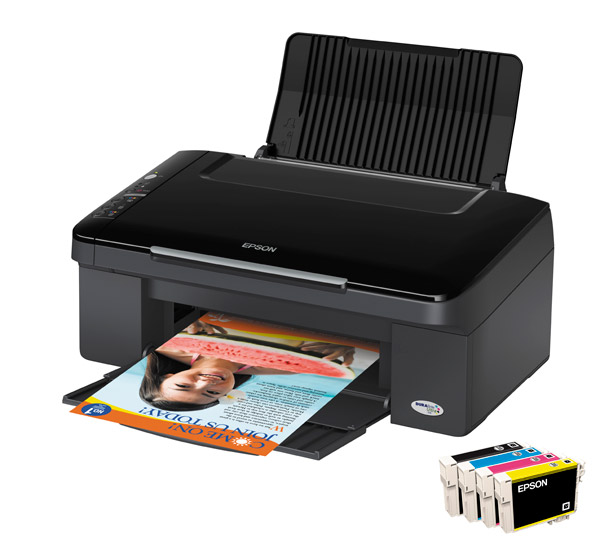
We have removed part of the paper feed system from the mechanism to assist illustrating the workings of the printer.
When the printer is not in use, the print head rests on the print head cap. The print cap functions as a ‘home’ for the print head performing the following functions:
- Securely parks and stores the print head when not in use.
- Keeps the print head free of dust.
- Cleans any old ink from the head surface to prevent old ink dropping onto printouts or clogging up the print head.
- Collects wasted ink that is used to clean the print head during start-up or routine maintenance and feeds this to a collection system, typically a tube leading to a pad/sponge.
As you can see from the following photograph, the ink absorber pad in the printer is large and comprises of several layers. However it is not as large as the brother design from Part 1. This is partly due to the different designs of the Brother and Epson printer.
However unlike the Brother, This Epson printer has had very little waste ink relatively has been contained in the waste ink pad for a printer of this age.
Epson use the classic ‘top loader’ design where the ink tanks are mounted above the print head and ink is fed directly to the print head. The advantage of this design is simplicity - reduction of cost, parts, complexity and size. The disadvantage is the size of the ink tanks are limited as fitting larger tanks can impede the design and operation of the printer’s mechanism.
Brother printer uses a different method to feed ink from the ink tanks to the print head. Ink is fed from ink tanks via flexible tubes to the print head. The advantage of this design allows the ink tanks to be re-located within the printer to a more convenient, user accessible location than the core innards of the printer and allows for larger tanks to be installed. Additionally, ‘charging the tubes’ with ink before it enters the print head can assist with flow of ink .
The disadvantage is more wasted ink as any old or unused ink still present in the tubes can dry up and clog either the tubes or the print head, impeding printing.
Internal components of consumer inkjets are not user serviceable. As outlined in Part 1, do not bother attempting to service your printer yourself no matter how technically competent you think you are. It is not worth the time , effort and mess for little net gain. What is your time worth to you? Compare this to the cost of a new printer.
Printers are actually very complicated devices even though they may sell for $50 compared to say a hard disk or a wireless router. They comprise of many gears, cams, sensors, drive belts, many springs, lubricating oil, messy waste ink, cabinet clips that can easy break and especially for multi functions, many many carefully routed cables.
At NitroWare.net we do not say something such as ‘you will void its warranty’ or ‘no user serviceable parts inside’ for the sake of being politically correct, we say it because we mean it. Although we would love to see less and less modern printers ending up in landfill posing an environmental issue and wasting end users money, the reality of the situation is time and money, things many of us do not have the luxury of in this day and age. Just replace the printer if it breaks out of warranty. For the majority of consumers/end users a cheap unit at around the $50 mark will be more than sufficient for their needs. Creative, Business or Enterprise may need something more specific to their needs.
If the concept of ink being wasted or ‘going down the drain’ as we have coined, we have a few suggestions.
- Use a laser printer instead of an inkjet. These are more economical for high volume printing
- Buy a printer that suits your needs. If you only print a few documents every now and then an entry printer is fine. If you are printing 30 page reports several times a week a higher end middle of the road printer may be suitable. If you are a business or enterprise and are doing large volumes and require high availability, high consumable capacity, support for centralised management then a commercial grade printer is suitable.
- Using the wrong printer for the task will only end in frustration or wasted money. Not having your document print correctly at the last minute can mean failure.
- Use a business or enterprise grade inkjet which will have bigger and more economical ink tanks and possibly user replaceable waste management.
- Follow the manufacturers instructions for the use of your printer. do not unnecessarily turn the printer on and off at the wall if it is being used frequently. Turn it off at the wall only for long periods of it being used or for storage.
- Deal with it. Waste ink is a consequence of using an inkjet printer and it is normal behaviour.
See Part 1 of our series for more information for how a modern inkjet printer manages its ink supply. Where did all my printer ink go?
